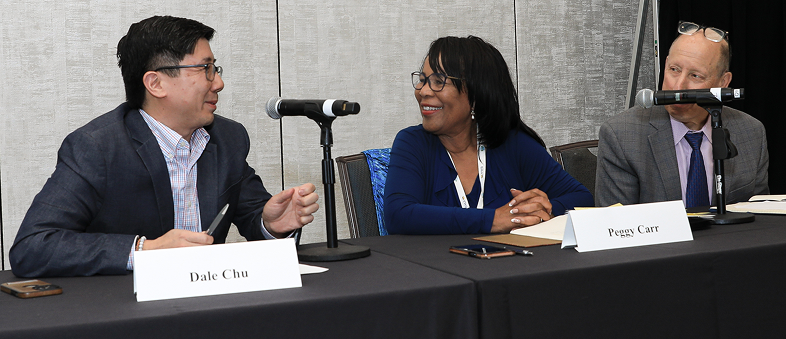
Storylines to Follow As Trump Overhauls K-12 and Higher Ed
The Trump administration is rapidly reshaping education policies. Here’s how to follow the changes.
Photo credits: Nruboc/Bigstock; James Minichello for EWA

The Trump administration is rapidly reshaping education policies. Here’s how to follow the changes.
Photo credits: Nruboc/Bigstock; James Minichello for EWA
The federal government’s influence over schools and colleges is growing as President Donald Trump tests the limits of the White House’s power. Though school policy has, historically, fallen mostly to state and local leaders, the Trump administration has made seismic shifts that have reverberated to schools across the country, increasingly demanding the attention of education beat reporters.
Over the summer, school administrators were left scrambling when the federal government froze – ultimately temporarily – roughly $7 billion dedicated for English learner programs, enrichment activities, adult education and more. An unprecedented number of schools and colleges have become the subjects of “directed investigations,” ordered by the Trump administration, often aimed at rooting out alleged antisemitism and preventing the participation of transgender girls in women’s sports, among other focuses. And deep cuts to the U.S. Department of Education have left state and district leaders unsure whether relied-upon federal funds will remain available.
The Trump administration did not respond to a list of questions for this reporting resource, but it has largely cast the moves as overdue efforts to trim federal bloat and combat diversity, equity and inclusion initiatives that it views as unfair to white people. Meanwhile, many educators and school leaders have described the rapid changes as destabilizing — and often politically motivated.
“Even if you’re a local reporter, it makes sense to pay attention to the federal level right now because that’s where all this uncertainty is coming from,” said Linda Jacobson, senior reporter for The 74.
Between board meetings and back-to-school stories, it can be tough to track all the federal developments. This reporting guide will provide tips to help simplify the process. It includes interviews with education leaders, researchers and a former high-ranking U.S. Department of Education official about the key storylines journalists should follow. Here’s what they said.
Experts advised that the impacts of reductions in staffing and funding at the federal level are trickling down to many school districts.
Soon after returning to the White House in January, Trump pledged his administration would close the U.S. Department of Education “as quickly as possible” — thrusting programs supporting multilingual learners, special education students, students experiencing homelessness and others into uncertainty.
As of July, the department was about half its size compared to when Trump took office, with cuts affecting nearly every part of the agency, The New York Times reported. And officials were looking to slim down or eliminate grants dedicated to a variety of initiatives as part of the Trump administration’s 2026 budget.
In some cases, federal cuts have also led to reductions in the workforce at state agencies, said Scott Marion, who works directly with state-level administrators as executive director of the National Center for the Improvement of Educational Assessment. Marion’s nonprofit organization supports states with student assessment and accountability. Some state administrators overseeing testing are funded through federal dollars, he said — and cuts could complicate the rollout of state exams.
A quick fairness reminder: When covering cuts, journalists should note how much money the federal government will save as a result. If 200 employee positions were eliminated, what are the projected annual costs recouped? On the other hand, will staffing cuts produce inefficiencies that will ultimately cost more for taxpayers?
Changes may produce significant savings. However, in most cases, according to Chu, the changes are saving “pennies, if anything, on the dollar,” compared to what’s needed to address the national budget deficit. The 2025 deficit stood at nearly $2 trillion in August, according to the Bipartisan Policy Center, and the Trump administration’s proposed changes to the U.S. Department of Education would save roughly $12 billion.
Journalists can also ask the federal government: How much savings will these changes produce? Are the funds being reallocated elsewhere, and, if so, where? How will the cuts change agency operations? Do the cuts threaten the agency’s essential functions?

The Office for Civil Rights (OCR), an agency meant to enforce federal civil rights law in schools, is among the branches of the Department of Education most affected by changes under the Trump administration. In March, seven of the Office’s 12 regional bureaus were instructed to close their doors. And the agency has largely shifted its focus away from investigations spurred by complaints — which often come from students, parents and educators — toward those directly ordered by the Trump administration.
The new approaches are completely inappropriate, argued Catherine Lhamon, who served as OCR chief under Biden. She is now executive director of the Edley Center on Law & Democracy at University of California, Berkeley School of Law.
The Trump administration puts a “thumb on the scale” by issuing press releases when new investigations are launched, Lhamon said, moving away from an innocent-until-proven-guilty approach of waiting until the investigation is complete to announce findings. She added that the narrowed focus on race in school admissions, antisemitism and transgender athletes signals “they care only about a small subset of the issues of their jurisdiction.”
“One thing I think is really important is not to cover the investigations as if they’re civil rights investigations – because they’re not,” Lhamon said. “What they’re actually doing is … attacking what can be thought, learned and understood in the university setting.”
The July passage of the One Big Beautiful Bill Act, a wide-ranging piece of legislation that advanced many of the Trump administration’s policy priorities, produced multiple changes education reporters may want to follow.
Perhaps most notably, the legislation created the nation’s first federal voucher program, which is set to go into effect in January 2027. Many of the program’s details must still be determined by the U.S. Treasury Department, said Chu of the Fordham Institute, and participation will be optional for states.
He thinks Democratic states may still be interested in participating if regulators allow the vouchers to cover enrichment opportunities like tutoring, rather than costs exclusively related to private school tuition.
“I’ve seen some left-leaning groups say, ‘If it works out to be something like that, then why wouldn’t a blue state want to take advantage of some additional resources?’” Chu said.
The bill also changed the borrowing caps on several types of federal loans, which may have big impacts on certain graduate and professional programs.
Your post will be on the website shortly.
We will get back to you shortly